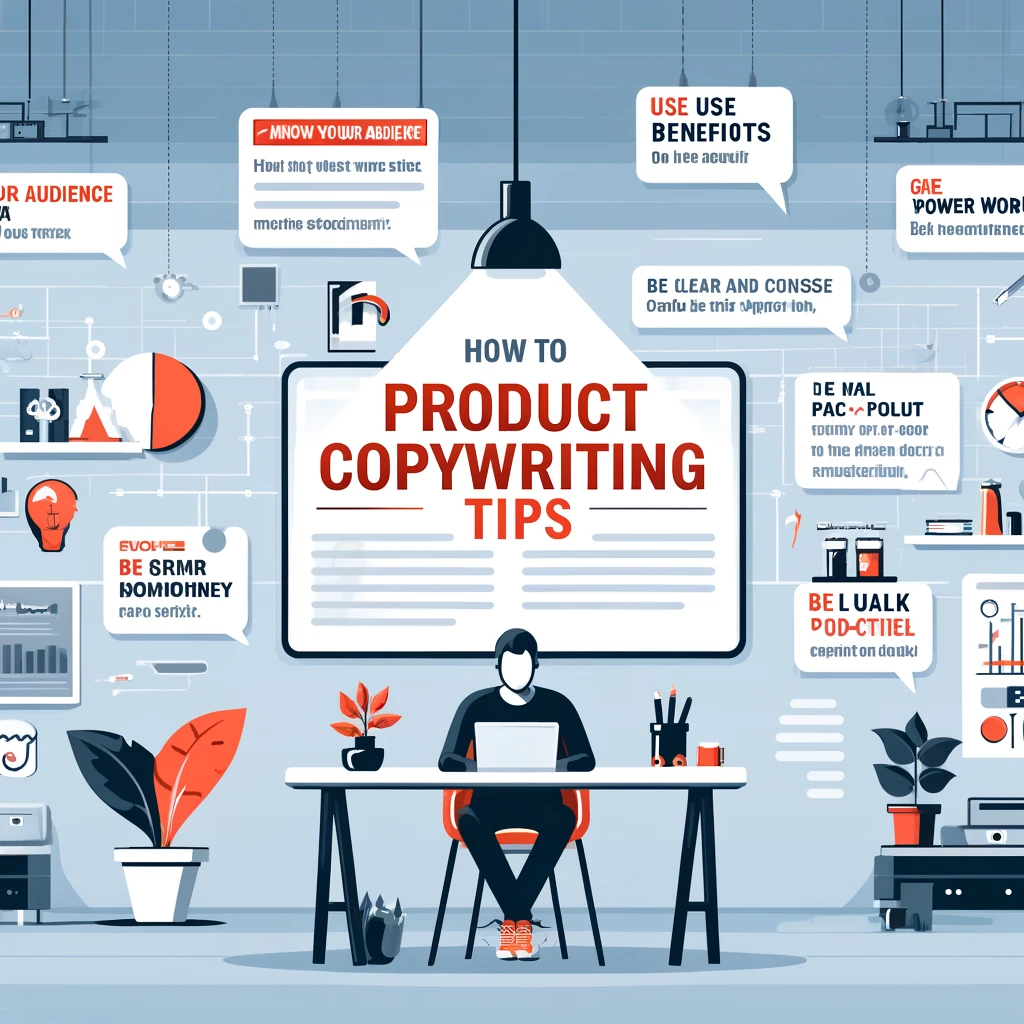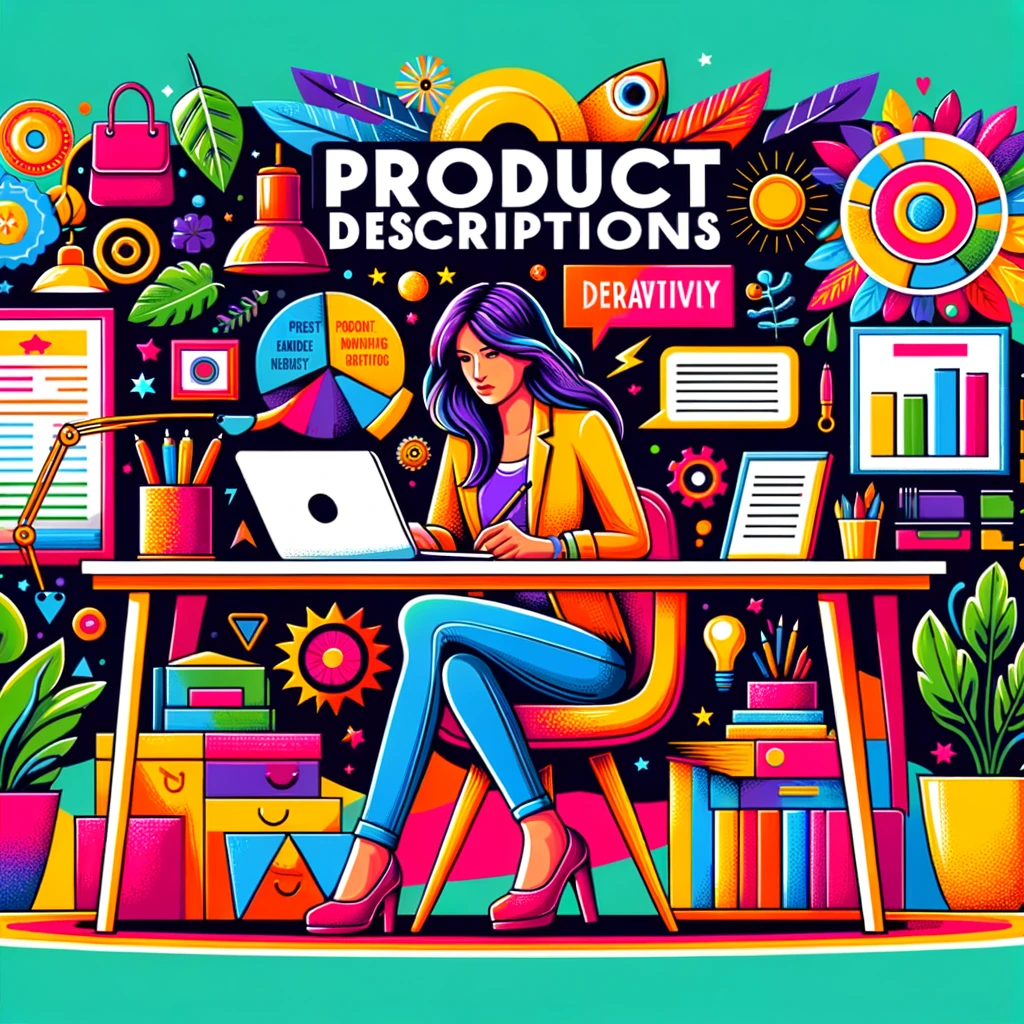
Product copywriting tips that will make your content standout and convert readers in to buyers.
- Introduction to Product Copywriting Tips
- Actionable Product Copywriting Tips
- 1. Your Audience
- 2. High-Quality Images
- 3. Benefits: Persuasive Product Descriptions
- Descriptive Language: Bringing Products to Life
- 4. Clarity and Conciseness
- 5.Creating a Sense of Urgency: Driving Action Through Persuasive Messaging
- 6. Social Proof: Building Trust Through Customer Feedback
- 7. Search Engines: Visibility Through Keyword Optimisation
- 8. Telling a Story: Building Emotional Connections Through Product Copy
- 9. Ending with a Strong Call to Action: Prompting Action for Conversion
- Conclusion on Product Copywriting Tips
Introduction to Product Copywriting Tips
Welcome to our blog! Are you eager to elevate your product descriptions for increased sales and engagement? Here we have put together some product copywriting tips that will transform your product copy into a sales powerhouse.
Whether you’re a novice or a seasoned copywriter, these tips will equip you with the tools to write product descriptions that captures attention and compels your readers to make a purchase.
Importance of Irresistible Product Copy
- Creating good product descriptions is more than a task or tick on ‘to do list’ but an opportunity to drive sales and enhance customer engagement.
- Great product copy has the potential to turn browsers into buyers and transform your online presence.
Building Brand Identity
- Compelling product descriptions are a reflection of your brand’s identity, conveying its values, personality, and unique selling propositions.
- Good product copywriting will help you establish a memorable brand identity that resonates with your target audience and sets you apart from competitors.
Actionable Product Copywriting Tips
Now, let’s look into the product copywriting tips that will revolutionise your approach to product copywriting and empower you to create descriptions that captivate and convert.
1. Your Audience

Understanding your audience is the cornerstone of effective product copywriting. Demographics, interests, and pain points of your target market will help you tailor your product copy to relate with their needs and desires.
Demographics, Interests, and Pain Points
- Demographics: Gain insights into the age, gender, location, and other relevant demographic factors of your target audience. This information helps you create content that speaks directly to your demographic profile.
- Interests: Explore the hobbies, preferences, and lifestyle choices of your audience to uncover what resonates with them. Align your product copy with their interests, capture their attention and foster a deeper connection.
- Pain Points: Identify the challenges, frustrations, and pain points that your audience experiences. Address these pain points in your product copy and demonstrate empathy and position your product as the solution they’ve been searching for.
Keyword Research Tools
Keyword research is essential for understanding the language and phrases your audience uses when searching for products online. Using keyword research tools, you can uncover valuable insights into the terms and phrases that resonate with your target market.
- Identify Relevant Keywords: Use tools like Google Keyword Planner, SEMrush, or Ahrefs to identify relevant keywords related to your product niche. Focus on long-tail keywords that are specific to your audience’s search intent.
- Understand Search Intent: Analyse the search intent behind each keyword to ensure that your product copy aligns with what your audience is looking for. Whether they’re seeking information, comparison, or purchase, tailor your content to meet their needs.
- Optimise for SEO: Incorporate relevant keywords naturally throughout your product copy to improve search engine visibility and attract organic traffic to your website. However, ensure that the keywords seamlessly fit within the context of your content to maintain readability and authenticity.
Creating Customer Personas
Customer personas are fictional representations of your ideal customers, based on real data and insights. Developing detailed customer personas allows you to gain a deeper understanding of your audience’s preferences, motivations, and pain points.
- Gather Data: Collect data from various sources, including surveys, interviews, social media analytics, and website analytics, to build comprehensive customer personas.
- Identify Patterns and Trends: Analyse the data to identify common patterns, trends, and behaviours among your target audience. Look for recurring themes or preferences that can inform your product copywriting strategy.
- Craft Personas: Use the insights gathered to create detailed customer personas that represent different segments of your target audience. Give each persona a name, background, and set of characteristics to humanise your audience and guide your content creation efforts.
Know your audience inside and out, use of keyword research tools, and create detailed customer personas.
2. High-Quality Images

High-quality images creates a visual appeal of your product pages and captures the attention of your readers. Visually appealing images can significantly impact the success of your product copy.
Showcasing Your Product
- Highlighting Product Features: Include images that showcase your product from different angles, allowing customers to get a comprehensive view of its features and design. Close-up shots can highlight specific details, while lifestyle images demonstrate the product in use.
- Creating Visual Interest: Choose images that are visually appealing and professionally shot to capture the attention of your audience. Vibrant colours, crisp details, and engaging compositions can make your product stand out and entice customers to explore further.
Optimising Images for SEO
- Incorporating Alt Text: Optimise your images for search engines by including descriptive alt text that accurately describes the contents of each image. Alt text not only improves accessibility for visually impaired users but also provides valuable context for search engine crawlers.
- Optimising Filenames: Use descriptive filenames for your images that include relevant keywords related to your product. This helps search engines understand the content of your images and improves their visibility in image search results.
Providing a Comprehensive View
- Zoom-In Options: Offer zoom-in functionality on your product images to allow customers to inspect details more closely. This feature enhances the user experience and enables potential buyers to make informed purchasing decisions.
- Multiple Images: Include multiple images of your product showcasing different angles, colours, or variations. Providing a variety of images gives customers a better understanding of the product and increases their confidence in making a purchase.
Use high-quality images that showcase your product effectively, and optimised for SEO with descriptive alt text and filenames. Provide zoom-in options and multiple images for a comprehensive view to improve the overall user experience.
3. Benefits: Persuasive Product Descriptions

- Importance of focusing on benefits rather than features in product copywriting.
- Addressing customer needs and desires can lead to more effective sales pitches.
Why Focus on Benefits?
- Customer-Centric Approach: Tailoring product descriptions to address customer needs.
- Emotional Connection: Highlighting how the product can improve customers’ lives.
- Problem-Solving: Demonstrating how the product solves specific customer challenges.
Value Propositions
- Identify Customer Pain Points: Understanding what matters most to your target audience.
- Crafting Compelling Value Propositions: Communicating the unique value your product offers.
- Highlighting Solutions: Illustrating how your product addresses customer needs effectively.
Benefits Over Features
- Features vs. Benefits: Differentiating between product attributes and customer advantages.
- Customer-Oriented Messaging: Framing product descriptions in terms of customer benefits.
- Clear Communication: Using simple language to communicate the value proposition.
SEO Optimisation
- Keyword Integration: Use relevant keywords naturally into product descriptions.
- SEO-Friendly Content: Writing content that resonates with both customers and search engines.
- Optimising Meta Tags: Ensuring meta titles and descriptions highlight product benefits.
- Storytelling: Using anecdotes or narratives to create an emotional connection with customers.
- Clarity and Conciseness: Keeping product descriptions clear, concise, and easy to understand.
- Call to Action: Encouraging customers to take action with a clear and compelling call to action.
Descriptive Language: Bringing Products to Life
- Use vivid and descriptive language to enhance product descriptions.
- Showcasing unique qualities can captivate readers and drive sales.
The Power of Descriptive Language
- Creating Visual Imagery: Encouraging readers to imagine using the product in their own lives.
- Engaging the Senses: Describing how the product looks, feels, smells, and sounds.
- Eliciting Emotions: Using language that evokes specific emotions or feelings in the reader.
- Specificity: Being specific and detailed in describing the product’s attributes and benefits.
- Avoiding Clichés: Steer clear of overused phrases and clichés, opting for original and authentic language.
- Match Tone to Audience: Tailoring the tone and style of language to resonate with the target audience.
Showcasing Unique Qualities
- Identifying USPs: Highlighting the product’s unique selling points that set it apart from competitors.
- Stressing Benefits: Connecting unique features to the benefits they provide to the customer.
- Demonstrating Value: Illustrating why the product is worth purchasing over alternatives.
4. Clarity and Conciseness

- Clarity and conciseness in product descriptions.
- Explain how these qualities enhance understanding and engagement.
The Importance of Clarity
- Clear Communication: Ensuring that product descriptions are easy to understand for all audiences.
- Eliminating Ambiguity: Avoiding vague language or ambiguous terms that may confuse readers.
- Highlighting Key Information: Making sure that the most important details about the product are clearly presented.
Emphasising Conciseness
- Brevity is Key: Keeping product descriptions concise to maintain reader interest.
- Trimming Unnecessary Details: Removing any information that does not directly contribute to the understanding of the product.
- Getting to the Point: Presenting information in a straightforward manner without unnecessary embellishment.
Avoiding Jargon and Complexity
- Accessible Language: Using simple and straightforward language that everyone can understand.
- Steering Clear of Technical Terms: Avoiding industry-specific jargon that may be unfamiliar to some readers.
- Focus on Benefits: Highlighting the benefits of the product in clear and relatable terms, rather than technical specifications.
5.Creating a Sense of Urgency: Driving Action Through Persuasive Messaging

- Urgency in product copywriting and its effectiveness in prompting immediate action.
- Phrases like “limited time offer” or “while stocks last” can encourage customers to make a purchase.
The Power of Urgency
- Prompting Immediate Action: Highlighting the urgency of the offer encourages customers to act quickly.
- Creating FOMO (Fear of Missing Out): Instilling a sense of urgency taps into customers’ fear of missing out on a great deal.
- Driving Conversions: Urgency prompts customers to make a purchase decision faster, leading to increased sales.
Effective Messaging Techniques
- Limited Time Offers: Communicating that the offer is only available for a short period adds urgency to the message.
- Scarcity Phrases: Using phrases like “while stocks last” or “limited availability” emphasises the scarcity of the offer.
- Action-Oriented Language: Encouraging customers to act now with clear calls to action such as “Shop Now” or “Don’t Miss Out.”
Creating a Compelling Call to Action:
- Clear and Direct: The call to action should be concise and straightforward, guiding customers on what to do next.
- Sense of Immediacy: Using language that conveys urgency, such as “Act Fast” or “Shop Today.”
- Emphasising Benefits: Highlighting the benefits of taking action now, such as saving money or securing a special offer.
6. Social Proof: Building Trust Through Customer Feedback

- Social proof in product copywriting and its role in building trust and credibility.
- Testimonials and reviews from satisfied customers can reassure potential buyers and influence purchasing decisions.
The Value of Social Proof
- Building Trust: Testimonials and reviews provide third-party validation of the product’s quality and effectiveness.
- Establishing Credibility: Positive feedback from satisfied customers enhances the brand’s credibility and reputation.
- Influencing Purchasing Decisions: Potential buyers are more likely to trust and purchase from brands with social proof.
Showcasing Positive Feedback
- Testimonials: Highlighting quotes or testimonials from satisfied customers praising the product’s benefits.
- Reviews: Showcasing positive reviews and ratings from customers who have purchased and used the product.
- Case Studies: Presenting real-life examples of how customers have benefited from using the product.
Reassuring Potential Buyers
- Addressing Concerns: Social proof addresses potential buyers’ concerns by demonstrating that others have had positive experiences with the product.
- Providing Assurance: Testimonials and reviews reassure potential buyers that they are making a wise purchasing decision.
- Reducing Risk: Social proof helps to mitigate the perceived risk of purchasing the product by providing evidence of its value and effectiveness.
7. Search Engines: Visibility Through Keyword Optimisation

- Optimising product copywriting for search engines to improve visibility and drive traffic.
- Relevant keywords and optimising meta tags for better search engine rankings.
Relevant Keywords
- Research Keywords: Conduct keyword research to identify relevant terms and phrases that potential customers are searching for.
- Natural Integration: Seamlessly incorporate keywords into product descriptions in a way that reads naturally and enhances understanding.
- Focus on User Intent: Prioritise keywords that align with the searcher’s intent and the product’s features and benefits.
Importance of Optimising Meta Tags
- Meta Titles: Craft compelling meta titles that accurately reflect the content of the product description and include relevant keywords.
- Meta Descriptions: Write concise and persuasive meta descriptions that entice users to click through to the product page while incorporating targeted keywords.
- Alt Tags: Optimise alt tags for images by providing descriptive and keyword-rich text to improve accessibility and enhance SEO.
Benefits of Keyword Optimisation
- Improved Visibility: Optimising product copywriting for keywords increases the likelihood of the content appearing in relevant search engine results.
- Higher Click-Through Rates: Compelling meta titles and descriptions that incorporate targeted keywords can attract more clicks from search engine users.
- Enhanced User Experience: Relevant keywords help users find the information they’re looking for quickly and easily, improving overall satisfaction.
8. Telling a Story: Building Emotional Connections Through Product Copy

- Storytelling in product copywriting and its power to create emotional connections with the audience.
- Sharing anecdotes or narratives that resonate with readers and illustrate the value of the product.
The Power of Storytelling as one of our Product Copywriting Tips
- Creating Emotional Connections: Stories evoke emotions and help readers connect with the brand on a deeper level.
- Engagement and Retention: Stories capture attention and keep readers engaged, increasing the likelihood of conversion.
- Memorability: Stories are more memorable than dry facts, making the brand and product more memorable to consumers.
Crafting Compelling Narratives:
- Know Your Audience: Tailor stories to resonate with the desires and pain points of your target audience.
- Highlight Benefits: Use storytelling to illustrate how the product can improve the customer’s life or solve a problem.
- Create Characters: Introduce characters or personas that represent your target audience and their journey with the product.
Illustrating Product Benefits:
- Before and After Scenarios: Paint a picture of how the customer’s life will be improved after using the product.
- Customer Testimonials: Share real-life stories from satisfied customers who have experienced positive outcomes.
- Use Visuals: Incorporate images or videos that enhance the storytelling experience and bring the product to life.
Building Emotional Connections:
- Appeal to Emotions: Evoke emotions such as joy, excitement, or relief to create a bond with the reader.
- Empathy and Understanding: Show empathy for the reader’s struggles and demonstrate how the product can provide a solution.
- Inspire Action: Use storytelling to inspire readers to take action, whether it’s making a purchase or signing up for more information.
9. Ending with a Strong Call to Action: Prompting Action for Conversion

- Including a strong call to action (CTA) in product copywriting to prompt readers to take action.
- CTA in guiding readers towards conversion and achieving marketing goals.
CTA (Call to Action)
- Be Clear and Direct: Use concise language that clearly communicates the desired action, whether it’s making a purchase, signing up for updates, or exploring related products.
- Create a Sense of Urgency: Encourage immediate action by incorporating phrases like “Shop Now” or “Limited Time Offer” to create a sense of urgency.
- Highlight Benefits: Emphasise the benefits of taking the desired action, such as saving money, gaining access to exclusive deals, or staying updated on the latest products.
Encouraging Conversion
- Make it Easy: Ensure that the CTA is easily accessible and prominently displayed on the product page.
- Provide Multiple Options: Offer multiple CTAs throughout the product description to cater to different preferences and stages of the customer journey.
- Use Persuasive Language: Use persuasive language that motivates readers to act, such as “Don’t Miss Out” or “Start Saving Today.”
Tailoring CTAs to the Audience
- Know Your Audience: Tailor CTAs to resonate with the desires and needs of your target audience.
- Segmentation: Use segmentation to deliver personalised CTAs based on factors such as browsing behaviour, location, or purchase history.
- A/B Testing: Experiment with different CTAs to identify which ones resonate best with your audience and drive the highest conversion rates.
Conclusion on Product Copywriting Tips
- Focus on Benefits: Emphasise the value your product brings and how it solves customer needs.
- Social Proof: Showcase testimonials and reviews to build trust and credibility.
- Use Descriptive Language: Paint a vivid picture to engage readers and highlight unique qualities.
- Create Urgency: Prompt action with limited-time offers and scarcity phrases.
- Tell a Story: Connect emotionally with readers through compelling narratives.
- End with a Strong Call to Action: Encourage conversion with clear and persuasive CTAs.
Encouragement to Apply Tips:
- Apply these strategies to your own product copywriting efforts to enhance engagement and drive conversions.
- Experiment with different techniques and adapt them based on audience feedback and performance metrics.
Invitation for Feedback and Engagement:
- We’d love to hear your thoughts and experiences with implementing these tips in your own product copywriting.
- Join the conversation and comment below and share your successes, challenges, and insights with Product Copywriting Tips to foster a supportive community of copywriters.
By applying these strategies and techniques to your product copywriting, you can create compelling content that resonates with your audience, drives engagement, and ultimately leads to increased sales and success for your business
We hope this article helped you learn about Product Copywriting Tips. You may also want to see our guide on more product copywriting here




